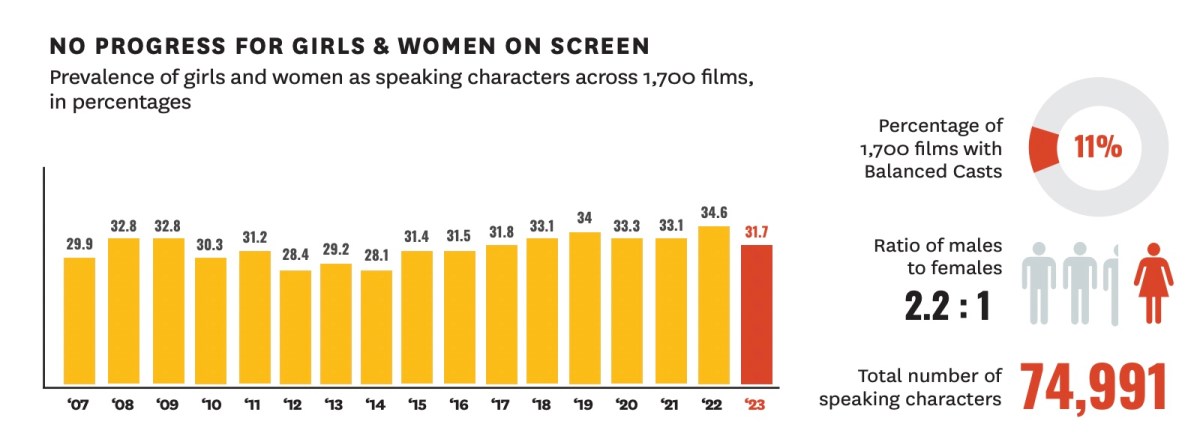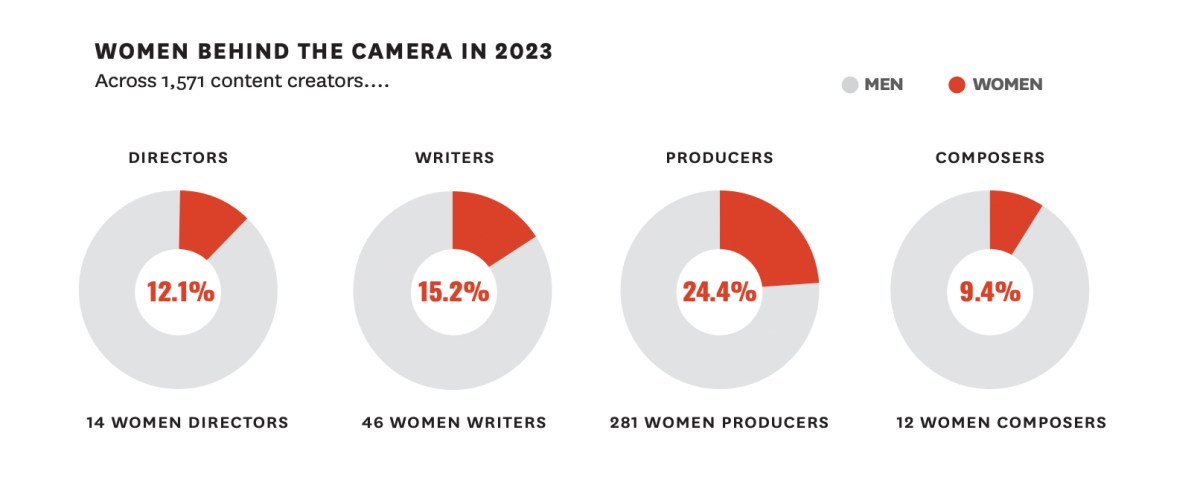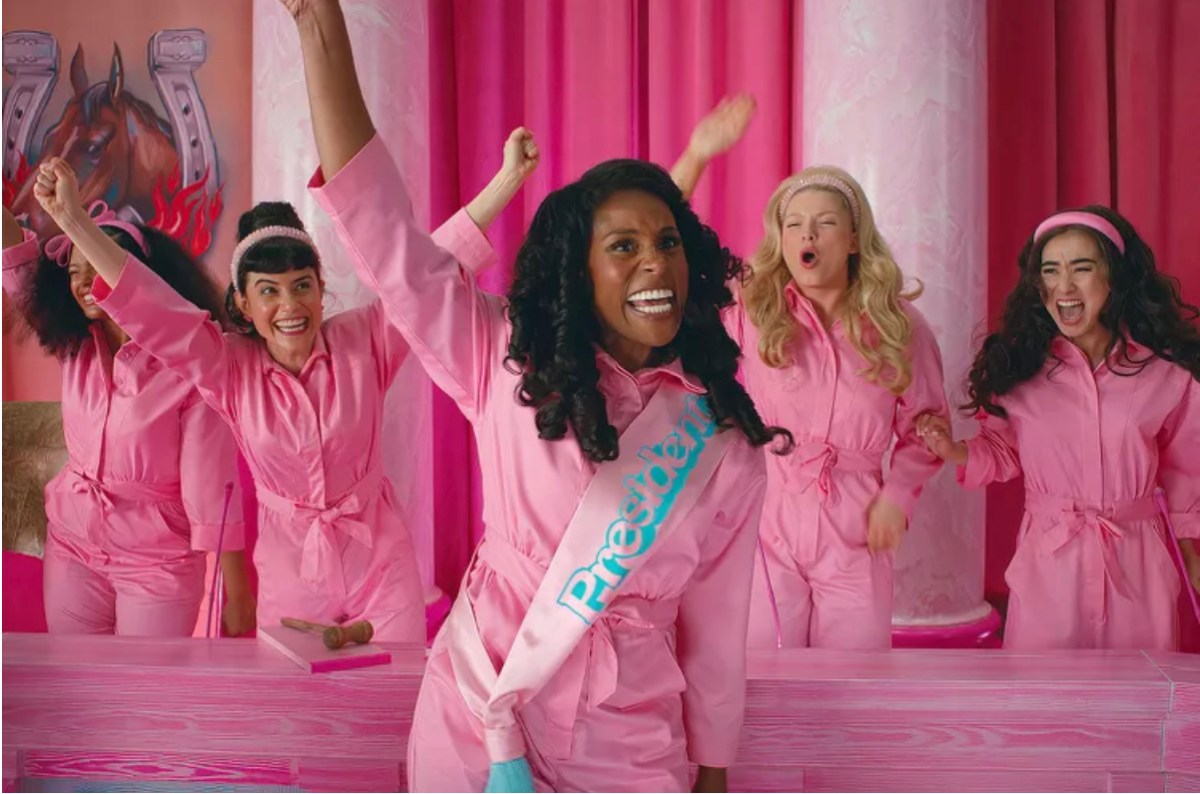Greta Gerwig and Margot Robbie’s Barbie was tops at the box office in 2023, but despite that beacon of pink positivity, the picture for women and diverse characters in Hollywood films is, in many ways, just as grim as it was in 2010, according to the August report by The Annenberg Inclusion Initiative.
This data-driven study of inequality, published annually by the USC Annenberg School for Communication and Journalism and now in its 17th edition, looked at 1,700 top grossing Hollywood films from 2007 to 2023, examining portrayals of gender, race/ethnicity, LGBTQ+ and disability – and the picture was far from pretty.
While it should be noted that this data relates to the top grossing films in North America, the results match pretty closely with global box office. The report tells us a lot about the films that are being served to the majority of cinema audiences.
The findings suggest that when it comes to mainstream movie-making, despite the increasingly visible equity and inclusion rhetoric, we’re not actually making much progress. Most strikingly, the percentage of female speaking characters has not meaningfully changed since 2007.
According to the Annenberg Inclusion Initiative Report, ‘Girls/women comprised 31.7% of speaking or named roles across the 100 top films of 2023 and this percentage did not differ from the top 100 films of 2022 (34.6%) or 2007 (29.9%).’

Not the Year of the Woman in Hollywood
‘No matter how you examine the data, 2023 was not the “Year of the Woman”,’ said Annenberg Inclusion Initiative Founder Stacy L. Smith in a statement. ‘We continue to report the same trends for girls and women on screen, year in and year out.
‘It is clear that there is either a dismissal of women as an audience for more than one or two films per year, a refusal to find ways to create meaningful change or both. If the industry wants to survive its current moment, it must examine its failure to employ half the population on screen.’
ScreenHub: Hard data in the toughest market shows value of diversity
Some of the key takeaways from the 2024 Annenberg Inclusion Report
- Of the 100 top grossing films in 2023, only 30 depicted a girl or woman as a lead or co-lead (whereas in 2022, it was 44, so we’ve gone backwards).
- Of those 30 films depicting a girl or woman as lead or co-lead, only 14 had a female lead or co-lead from an underrepresented racial or ethnic group.
- Only 11 % of 2023’s top films were gender-balanced, or featured girls and women in 45 to 54.9% of speaking roles.
- Less than 1% of characters in 2023 were gender nonbinary.
- Girls and women of colour led only 14 films in 2023, down from 18 in 2022, but higher than the one movie in 2007 that featured a woman of colour protagonist.
- Only one movie in 2023 starred a woman of colour aged 45 or older in a leading role.
- There were only 2.2% of all speaking or named characters depicted with a disability across the top 100 films in 2023.
- Transgender characters were entirely absent among the top-grossing films of the year, while fewer queer characters were depicted overall compared to 2022.
If you’re not a white girl or woman, you’re almost invisible
Only 12 of the top-grossing movies did not include any white girls or women on screen. But 99 of them were missing female characters who are American Indian/Alaska Native or Native Hawaiian/Pacific Islanders; 81 of them didn’t include a Middle Eastern/North African female character; and 62 films did not feature a Hispanic/Latina female-identifying character.
Furthermore, 49 films did not feature an Asian female character, and 39 were missing Black female characters.

Ageism and sexism combined
According to the data, only three of the top grossing films of 2023 had a female lead or co-lead who was 45 years or older.
The report’s summary was damning of the depiction of even older women. ‘Only 22 older women (65 years of age or older) were cast in ensemble storylines across 1,700 movies from 2007 to 2023. Of these, 16 roles were filled by actors working more than one time (Candice Bergen, Diane Keaton, Jane Fonda, Judi Dench, Maggie Smith, Mary Steenburgen). This is less than one per year.’
Ray of hope
One small ray of hope was the increase of Asian characters on screen which increased significantly from 2007 to 2023, going from 3% to 18%, though was up only slightly from 16% in 2022.
As you’d expect, movies with Asian directors in 2023 were more likely to have Asian leads/co leads and Asian speaking characters than those films without an Asian director attached. The report found no other significant changes for other racial/ethnic groups over 17 years of the study.
Behind the camera
The statistics from behind the camera were similarly dispiriting, suggesting only small improvements – for instance, women were 12% of the directors behind the top 2023 films, slightly up on 9% for 2022, and significantly up from 3% in 2007.
In terms of composing film music, in 2023, 90.6% of composers were men and only 9.4% were women, but at least that’s a big improvement on zero in 2007.
Other dire stats to ponder
- 878 individual men directed top-grossing films between 2007 and 2023, but only 98 women
- Only 25 of these female directors were women of colour.
- 78% of all directors of top grossing films in this period were white.
- 84% of writers across the 100 top movies of 2023 were men, with 15.2% women. In 2007 women represented 11.2% of writers.

The report makes for depressing reading – and even more of an encouragement to seek out cinema that is made outside the Hollywood studio system – the kinds of films that play in arthouse cinemas and at festivals.
Recommendations: Just Add Five!
As for recommendations, the report calls for less talk and more direct action on diversity and inclusion targets. It says the study should serve as a reality check and a warning to the entertainment industry and consumers who may get the vibe that with films like Barbie, The Little Mermaid, Poor Things and The Colour Purple that the job is getting done and inclusion targets are no longer necessary.
According to the report, ‘To date, 29 US states have introduced or enacted legislation to curb efforts toward DEI12 and the very phrase seems to induce apathy or enmity.
‘Yet the film industry has an opportunity that few other arenas can boast. By telling stories that feature the diversity and breadth of the human experience – including people from all genders, races/ethnicities, sexualities, and ability levels – movies can create empathy and provide an opportunity to overcome stereotypes and prejudices that still exist. Doing so, however, requires embracing the chance to tell different stories and support new storytellers. When that happens this report will begin to reflect reality rather than a skewed representation of a world we do not inhabit.’
The report calls for new decision making processes that swerve away from just repeating what’s worked before, with endless variations on superhero movies being the most obvious result.
Another solution advanced by the report it the ‘Just Add Five’ initiative – adding five female-identified
characters from a variety of backgrounds to each film in the top 100.
‘In less than five years, this strategy would lead to gender parity across the top 100 films and would improve representation of other groups.’





